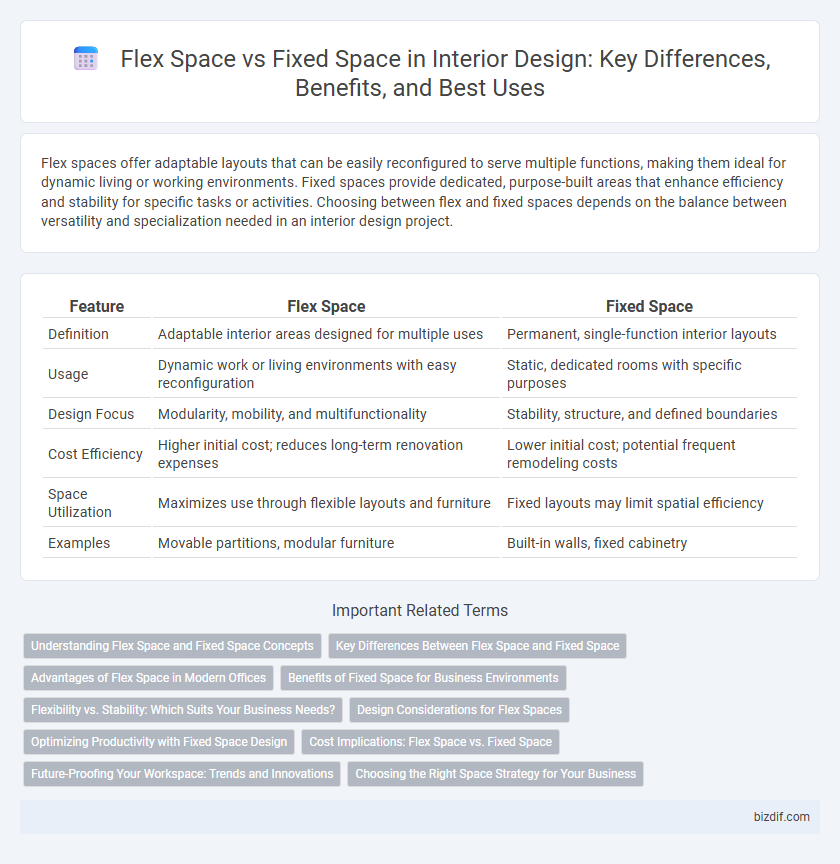Flex spaces offer adaptable layouts that can be easily reconfigured to serve multiple functions, making them ideal for dynamic living or working environments. Fixed spaces provide dedicated, purpose-built areas that enhance efficiency and stability for specific tasks or activities. Choosing between flex and fixed spaces depends on the balance between versatility and specialization needed in an interior design project.
Table of Comparison
| Feature | Flex Space | Fixed Space |
|---|---|---|
| Definition | Adaptable interior areas designed for multiple uses | Permanent, single-function interior layouts |
| Usage | Dynamic work or living environments with easy reconfiguration | Static, dedicated rooms with specific purposes |
| Design Focus | Modularity, mobility, and multifunctionality | Stability, structure, and defined boundaries |
| Cost Efficiency | Higher initial cost; reduces long-term renovation expenses | Lower initial cost; potential frequent remodeling costs |
| Space Utilization | Maximizes use through flexible layouts and furniture | Fixed layouts may limit spatial efficiency |
| Examples | Movable partitions, modular furniture | Built-in walls, fixed cabinetry |
Understanding Flex Space and Fixed Space Concepts
Flex space refers to interior environments designed for multiple functions, allowing easy adaptation and reconfiguration to meet varying user needs. Fixed space, in contrast, is designed with a singular, unchanging purpose, often defined by permanent walls, fixtures, and layouts that limit versatility. Understanding these concepts helps optimize space utilization by balancing flexibility and stability according to functional requirements.
Key Differences Between Flex Space and Fixed Space
Flex space offers versatile functionality allowing easy reconfiguration for multiple uses, ideal for dynamic environments needing adaptability. Fixed space is designed for a specific purpose with permanent fixtures and layouts, optimal for consistent, singular use. Key differences lie in spatial flexibility, cost implications, and long-term utility, where flex space supports evolving needs while fixed space prioritizes stability and efficiency.
Advantages of Flex Space in Modern Offices
Flex space in modern offices offers unparalleled adaptability, allowing businesses to reconfigure layouts quickly to accommodate changing team sizes and functions. This flexibility enhances collaboration and productivity by creating dynamic environments tailored to diverse work styles. Cost-efficiency is another key advantage, as flex spaces reduce the need for long-term leases and extensive renovations compared to fixed spaces.
Benefits of Fixed Space for Business Environments
Fixed spaces in business environments offer enhanced privacy and noise control, creating a focused atmosphere essential for productivity. These spaces enable consistent layout optimization tailored to specific operational needs, improving workflow efficiency and employee comfort. Moreover, fixed spaces often contribute to a strong brand identity through permanent, customized interior design elements.
Flexibility vs. Stability: Which Suits Your Business Needs?
Flex space offers versatility by allowing businesses to adapt layouts quickly for evolving operational demands, ideal for dynamic work environments prioritizing collaboration and growth. Fixed space ensures structural stability with permanent configurations that support long-term, consistent workflows, suitable for businesses valuing predictability and dedicated functions. Choosing between flex and fixed spaces depends on whether a company prioritizes adaptability to change or the reliability of a stable environment.
Design Considerations for Flex Spaces
Flex spaces in interior design prioritize adaptability, incorporating modular furniture, movable partitions, and multifunctional elements to maximize usability. Designers must assess lighting, acoustics, and traffic flow to ensure the environment supports diverse activities and occupant needs. Emphasizing seamless integration of technology enhances flexibility while maintaining aesthetic coherence and spatial efficiency.
Optimizing Productivity with Fixed Space Design
Fixed space design enhances productivity by creating dedicated, consistent environments tailored to specific tasks, minimizing distractions and streamlining workflows. Incorporating ergonomic furniture, strategically placed storage, and optimized lighting in fixed spaces supports focus and reduces cognitive load. This approach ensures efficient use of space and fosters a professional atmosphere conducive to sustained high performance.
Cost Implications: Flex Space vs. Fixed Space
Flex space offers cost efficiency by minimizing construction expenses and allowing businesses to adapt layouts without major renovations, reducing long-term capital investments. Fixed spaces often incur higher initial costs due to customized builds and limited adaptability, resulting in potential future expenses for modifications or expansions. Choosing flex space can optimize budget allocation by balancing immediate setup costs with future flexibility to accommodate changing needs.
Future-Proofing Your Workspace: Trends and Innovations
Flex spaces prioritize modular furniture and adaptable layouts that accommodate evolving work styles, enhancing future-proofing by allowing swift reconfiguration. Fixed spaces integrate durable materials and infrastructure designed for long-term use but may limit adaptability to emerging technologies and new collaboration needs. Incorporating smart technology and sustainable design elements in both space types supports future-proof work environments by optimizing efficiency and employee well-being.
Choosing the Right Space Strategy for Your Business
Selecting the right space strategy for your business hinges on understanding the core differences between flex space and fixed space. Flex spaces offer adaptable layouts that support evolving business needs and optimize real estate costs through shared amenities and modular design. In contrast, fixed spaces provide stability and brand consistency with dedicated areas tailored to specific functions, making them ideal for businesses with predictable workflows and long-term operational plans.
Flex Space vs Fixed Space Infographic

 bizdif.com
bizdif.com